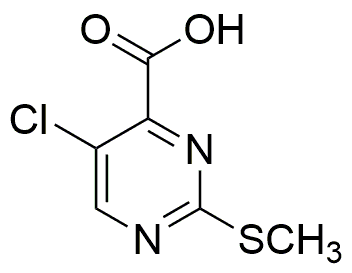5-Chloro-2-(methylthio)pyrimidine-4-carboxylic acid is widely utilized in research focused on:
- Agricultural Chemistry: This compound serves as a key intermediate in the synthesis of various agrochemicals, particularly herbicides. Its ability to inhibit specific plant enzymes makes it valuable for developing effective weed control solutions.
- Pharmaceutical Development: It is used in the synthesis of pharmaceuticals, especially in creating compounds that target specific biological pathways. Researchers appreciate its role in developing potential treatments for various diseases.
- Biochemical Research: The compound is utilized in studies exploring metabolic pathways and enzyme interactions. Its unique structure allows scientists to investigate the effects of sulfur-containing compounds in biological systems.
- Material Science: This chemical is explored in the development of novel materials, including polymers and coatings. Its properties can enhance the performance and durability of materials used in various applications.
- Analytical Chemistry: It is employed as a reference standard in analytical methods, aiding in the identification and quantification of similar compounds in complex mixtures, which is crucial for quality control in various industries.
General Information
Properties
Safety and Regulations
Applications
5-Chloro-2-(methylthio)pyrimidine-4-carboxylic acid is widely utilized in research focused on:
- Agricultural Chemistry: This compound serves as a key intermediate in the synthesis of various agrochemicals, particularly herbicides. Its ability to inhibit specific plant enzymes makes it valuable for developing effective weed control solutions.
- Pharmaceutical Development: It is used in the synthesis of pharmaceuticals, especially in creating compounds that target specific biological pathways. Researchers appreciate its role in developing potential treatments for various diseases.
- Biochemical Research: The compound is utilized in studies exploring metabolic pathways and enzyme interactions. Its unique structure allows scientists to investigate the effects of sulfur-containing compounds in biological systems.
- Material Science: This chemical is explored in the development of novel materials, including polymers and coatings. Its properties can enhance the performance and durability of materials used in various applications.
- Analytical Chemistry: It is employed as a reference standard in analytical methods, aiding in the identification and quantification of similar compounds in complex mixtures, which is crucial for quality control in various industries.
Documents
Safety Data Sheets (SDS)
The SDS provides comprehensive safety information on handling, storage, and disposal of the product.
Product Specification (PS)
The PS provides a comprehensive breakdown of the product’s properties, including chemical composition, physical state, purity, and storage requirements. It also details acceptable quality ranges and the product's intended applications.
Certificates of Analysis (COA)
Search for Certificates of Analysis (COA) by entering the products Lot Number. Lot and Batch Numbers can be found on a product’s label following the words ‘Lot’ or ‘Batch’.
*Catalog Number
*Lot Number
Certificates Of Origin (COO)
This COO confirms the country where the product was manufactured, and also details the materials and components used in it and whether it is derived from natural, synthetic, or other specific sources. This certificate may be required for customs, trade, and regulatory compliance.
*Catalog Number
*Lot Number
Safety Data Sheets (SDS)
The SDS provides comprehensive safety information on handling, storage, and disposal of the product.
DownloadProduct Specification (PS)
The PS provides a comprehensive breakdown of the product’s properties, including chemical composition, physical state, purity, and storage requirements. It also details acceptable quality ranges and the product's intended applications.
DownloadCertificates of Analysis (COA)
Search for Certificates of Analysis (COA) by entering the products Lot Number. Lot and Batch Numbers can be found on a product’s label following the words ‘Lot’ or ‘Batch’.
*Catalog Number
*Lot Number
Certificates Of Origin (COO)
This COO confirms the country where the product was manufactured, and also details the materials and components used in it and whether it is derived from natural, synthetic, or other specific sources. This certificate may be required for customs, trade, and regulatory compliance.


